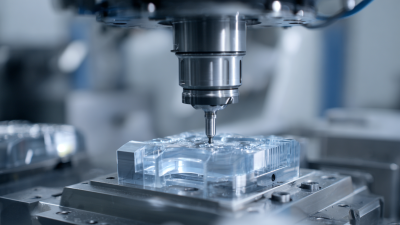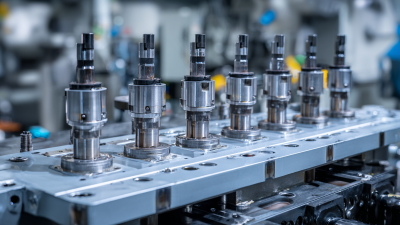
Exploring Innovative Alternatives to Injection Moldable Plastics for Sustainable Production
 The increasing demand for sustainable production methods has prompted a critical examination of traditional materials, particularly injection moldable plastics, which dominate the manufacturing sector. According to a report by the Plastics Industry Association, the production of plastic reached 367 million metric tons globally in 2020, with a significant portion attributed to injection-molded products. However, the environmental impact of these materials, including their contribution to pervasive plastic pollution and greenhouse gas emissions, cannot be overlooked. A recent study from the World Economic Forum indicates that if current trends continue, there could be more plastic than fish in the oceans by 2050. As industries seek to reduce their carbon footprint and enhance ecological sustainability, exploring innovative alternatives to injection moldable plastics has become paramount. This blog will delve into the reasons driving this shift while highlighting promising sustainable materials that can lead the way towards a more eco-friendly production landscape.
The increasing demand for sustainable production methods has prompted a critical examination of traditional materials, particularly injection moldable plastics, which dominate the manufacturing sector. According to a report by the Plastics Industry Association, the production of plastic reached 367 million metric tons globally in 2020, with a significant portion attributed to injection-molded products. However, the environmental impact of these materials, including their contribution to pervasive plastic pollution and greenhouse gas emissions, cannot be overlooked. A recent study from the World Economic Forum indicates that if current trends continue, there could be more plastic than fish in the oceans by 2050. As industries seek to reduce their carbon footprint and enhance ecological sustainability, exploring innovative alternatives to injection moldable plastics has become paramount. This blog will delve into the reasons driving this shift while highlighting promising sustainable materials that can lead the way towards a more eco-friendly production landscape.
Innovative Bio-based Plastics: Natural Solutions for Sustainable Designs
The quest for sustainable design solutions is increasingly leading manufacturers to explore innovative bio-based plastics. Unlike traditional injection-moldable plastics, which are derived from fossil fuels, these natural alternatives are produced from renewable resources such as corn, sugarcane, and even algae. This shift not only reduces dependence on non-renewable resources but also significantly lowers the carbon footprint associated with plastic production.
The development of bio-based plastics opens up a world of possibilities for creating materials that are not only environmentally friendly but also versatile and functional.
Incorporating innovative bio-based plastics into product design allows for a seamless blend of sustainability and aesthetic appeal. These materials can be engineered to meet various performance requirements, making them suitable for diverse applications—from packaging to consumer goods. By utilizing bioplastics, designers can create products that are not only biodegradable or compostable but also maintain the durability and quality expected from conventional plastics.
This evolution in material science presents an opportunity to reimagine how we think about production and consumption while prioritizing the health of our planet.
Recycled Plastics as a Sustainable Alternative: Closing the Loop in Production
The urgent need to address plastic pollution has prompted a significant shift towards the use of recycled plastics as a sustainable alternative in manufacturing. According to a report by the Ellen MacArthur Foundation, transitioning to a circular economy for plastics could generate an economic benefit of $1 trillion by 2030. This potential not only emphasizes the economic viability of recycled materials but also highlights the importance of closing the loop in production processes.
Recycled plastics offer a robust solution by reducing the reliance on virgin materials, which are often derived from fossil fuels. In fact, the Plastics Industry Association notes that using recycled plastics can cut carbon emissions by up to 78% compared to traditional plastics. As brands and manufacturers increasingly adopt these eco-friendly alternatives, they contribute to environmental sustainability while meeting consumer demand for greener products. This paradigm shift not only helps combat plastic waste but also promotes innovative approaches to material sourcing in the manufacturing sector, paving the way for a more sustainable future.
Exploring Paper and Cardboard Composites: Lightweight and Eco-friendly Choices
As the world increasingly pivots towards sustainability, the exploration of alternatives to traditional injection-moldable plastics has garnered considerable attention.
Paper and cardboard composites are emerging as innovative solutions that not only meet functional performance requirements but also significantly reduce environmental impact. According to a recent report from Smithers Pira, the global market for paper-based composites is expected to reach $5 billion by 2025, driven by a rising demand for eco-friendly materials across numerous industries.
These composites offer lightweight characteristics and are often biodegradable, making them an attractive option for packaging, construction, and automotive applications. Moreover, using paper and cardboard materials can reduce carbon emissions by up to 70% compared to conventional plastic production, as highlighted in a study by the Ellen MacArthur Foundation. This shift not only supports sustainable manufacturing practices but also aligns with consumer preferences for environmentally responsible products.
Tips: When considering the transition to paper and cardboard composites, always assess the lifecycle of the materials. Look for certifications such as FSC or PEFC to ensure sustainability. Additionally, engage with suppliers who prioritize eco-friendly practices to enhance your product’s overall environmental profile.

Utilizing Mycelium: Nature’s Technology for Sustainable Product Development
Mycelium, the vegetative part of fungi, is emerging as a groundbreaking alternative to traditional plastic materials. Utilizing mycelium for product development unlocks a myriad of sustainable opportunities by harnessing nature's own processes. This organic material is not only biodegradable but also renewable, making it a promising candidate for industries looking to reduce their ecological footprints. As consumers increasingly seek eco-friendly options, mycelium-based products offer an innovative solution that blends functionality with sustainability.
The remarkable versatility of mycelium allows it to be cultivated into various shapes and sizes, making it an ideal substitute for injection moldable plastics in packaging, design, and construction. By leveraging mycelium's natural growth process, manufacturers can create composite materials that are both lightweight and strong, further reducing resource consumption. This shift not only mitigates the environmental impact of plastic waste but also fosters a circular economy where materials can decompose naturally, returning nutrients to the earth. As research and development in mycelium technology continue to advance, it opens the door for a new era of sustainable product development that reconnects us with nature’s wisdom.
3D Printing with Sustainable Materials: Revolutionizing Traditional Manufacturing Methods
The shift towards sustainable manufacturing methods is gaining momentum, particularly through the adoption of 3D printing technologies. Traditional plastic injection molding often produces significant waste, leading to increased environmental degradation. In contrast, 3D printing, according to a report by Smithers, is expected to grow to a $35.6 billion industry by 2024, driven largely by the demand for more eco-friendly solutions. This technology allows for precise material usage, reducing scrap and enabling the use of sustainable materials such as bioplastics and recycled composites.

Additionally, research conducted by the Ellen MacArthur Foundation indicates that using 3D printing can contribute to the circular economy by extending product life cycles and encouraging repairs. With materials like PLA and newer innovations in environmentally friendly filaments, companies can minimize their carbon footprint while meeting the demand for customized, durable products. The potential of 3D printing to streamline production and employ sustainable materials redefines traditional manufacturing methods, making it a pivotal player in the quest for sustainable development in the plastics industry.
Related Posts
-

Exploring the Benefits and Applications of Various Injection Molding Products in Today's Industry
-

Quality Driven Global Success of Prototype Injection Molding from China
-

Creative Examples of Successful Injection Molding Applications Across Industries
-

5 Key Benefits of Investing in Injection Tooling for Global Buyers
-

Common Challenges Faced in Mold Plastic Injection Processes
-

Exploring Innovative Alternatives to Mold Plastic Injection in Modern Manufacturing: Trends and Insights
